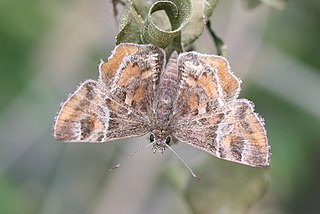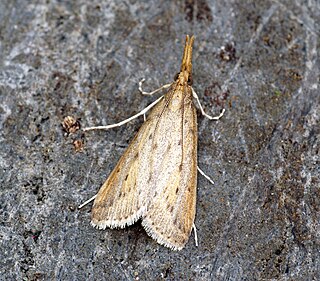
Logania distanti, the dark mottle, is a small but striking butterfly found in India that belongs to the lycaenids or blues. It was first described by Georg Semper in 1889.
The Field Elm cultivar Ulmus minor 'Viminalis Marginata', a variegated form of Ulmus minor 'Viminalis', was first listed as Ulmus campestris var. viminalis marginataHort. by Kirchner in 1864. Both Van Houtte and Späth marketed an U. campestris viminalis marginata in the late 19th century.

Eucalyptus pulverulenta, commonly known as silver-leaved mountain gum, is a species of straggly tree or mallee that is endemic to southern New South Wales. It has smooth bark, egg-shaped, heart-shaped or round, sessile leaves arranged in opposite pairs, flower buds in groups of three, white flowers and cup-shaped to cylindrical fruit.

Phragmatobia fuliginosa, the ruby tiger, is a moth of the family Erebidae.
Leptosteges is a genus of moths of the family Crambidae.

Ozola is a genus of moths in the family Geometridae first described by Francis Walker in 1861.

Systasea is a genus of skipper butterflies in the family Hesperiidae.

Anarta myrtilli, the beautiful yellow underwing, is a moth in the family Noctuidae. The species was first described by Carl Linnaeus in 1761. It is found in most of Europe including Scandinavia, Britain, France, Germany, Switzerland, Spain, Portugal, Italy, and Russia.
Platyptilia pulverulenta is a moth of the family Pterophoridae. It is found in New Zealand.
Chloroclystis leucopygata is a moth in the family Geometridae. It is found in Sulawesi as well as in India.

Schoenobiinae is a subfamily of the lepidopteran family Crambidae. The subfamily was described by Philogène Auguste Joseph Duponchel in 1846.
Leptosteges flavicostella is a moth in the family Crambidae. It was described by Charles H. Fernald in 1887. It is found in North America, where it has been recorded from Florida, South Carolina and Georgia.
Leptosteges fuscipunctalis is a moth in the family Crambidae described by George Hampson in 1896. It is found in Espírito Santo, Brazil.
Leptosteges onirophanta is a moth in the family Crambidae. It was described by Harrison Gray Dyar Jr. in 1914 and is found in Panama.
Dicepolia roseobrunnea is a moth in the family Crambidae. It was described by Warren in 1889. It is found from central and northern Bolivia and south-eastern Peru to north-eastern Brazil, from the Pantanal to the coastal range of the northern Andes, Trinidad, Guyana, Suriname and French Guiana. It has also been recorded from Honduras.
Coptotelia bipunctalis is a moth in the family Depressariidae. It was described by Warren in 1889. It is found in Brazil.

Toxicodryas pulverulenta, commonly known as Fischer's cat snake, Fischer's tree snake, and the powdered tree snake, is a species of rear-fanged venomous snake in the family Colubridae. The species is native to Sub-Saharan Africa.
Brevipecten captata is a moth of the family Noctuidae first described by Arthur Gardiner Butler in 1889.
Anomis figlina is a moth of the family Erebidae first described by Arthur Gardiner Butler in 1889. It is found in Sri Lanka, India, Australia and Japan.

Entomopteryx combusta is a moth of the family Geometridae first described by Warren in 1893. It is found in Sikkim in India, Sri Lanka, Java, Taiwan, and Japan.








